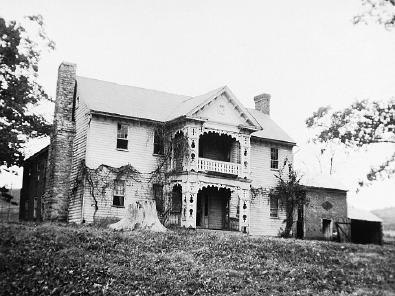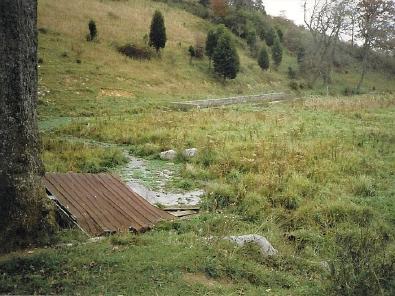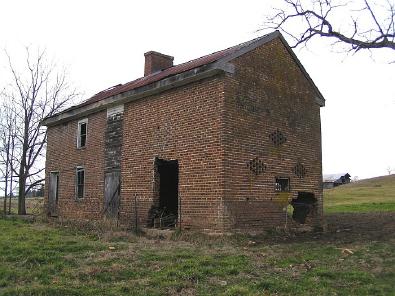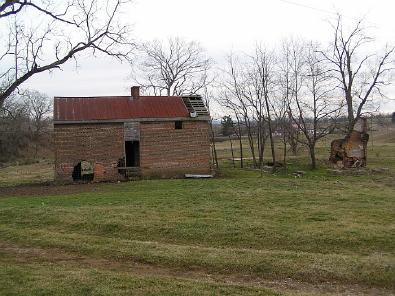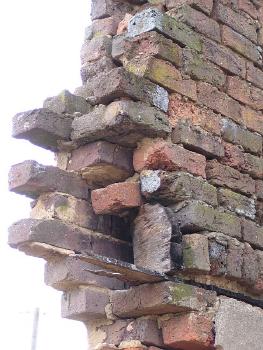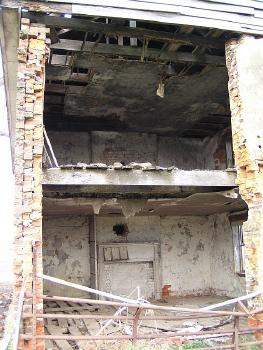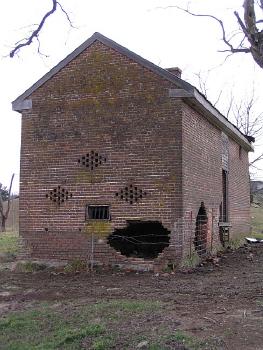Washington Co. > Homes and Buildings >Absalom Beattie home
Map link and Source List follows narrative.
Absalom Beattie was born in 1802. His grandfather, John Beattie, settled a large tract of land in Washington County in the late 1700s. The land stretched from present day Emory to east of present day Glade Spring. John Beattie gifted portions of it to several of his sons and sons-in-law but willed the bulk of the property to his youngest son William. In turn, William, who lived to almost 100 years of age, gifted portions of the land to two of his younger sons, Absalom and William, and then willed the bulk of his property to his youngest son Madison.
On April 12, 1825 William Beattie Sr. gifted Absalom 250 acres for $1. The property sat on the north side of present day Hillman Highway, about 1 1/2 miles east of Emory. Richardson Branch, named for a later owner, flows across the gently rolling land.
Absalom married Eliza Davis on 12 June 1832. They were the parents of at least 6 children.
Absalom built a rectangular log house with 4 rooms, 2 hallways, 9 foot ceilings and 30 inch thick walls. Two brick additions were added off the rear of the house. One of the additions served as slave quarters and included a room with small, barred windows reportedly used to house slaves who were being punished. Remnants of a kitchen are still visible in one of the brick rooms.
The log house was weatherboarded, probably in the mid 1800s. When Victoria Gilliam visited it in 1937 for the WPA Historical Inventory project she noted the fancy detail work on the porch, and commented on the elaborate painted walls and ceilings in one of the rooms. She also recorded that the original house had two stone chimneys and 3 stairways. The original home no longer stands, but at least one brick addition has survived.
Absolom Beattie was a successful farmer, but his farm's production was dependant on the slaves who worked his land. He owned 6 slaves in 1840; 12 slaves in 1850 and 16 by 1860. Several crops were raised on the land including wheat, Indian corn, Irish potatoes and oats. In addition Absalom was one of the few farmers in the area to grow tobacco.
However, with the loss of slave labor after the Civil War, and with the failure of a family business venture, Absalom was forced in 1868 to sell his farm and home in trust to pay his creditors. The family was allowed to remain in the home for 5 years while they tried to raise the capital, but in Feb. 1876 the property was sold, initially to Fayette McMullin and then to William C. Sanders. Sanders sold the property to George Beattie (son of Absalom's brother Madison) who then sold it to the Richardson family. Absalom and his second wife, Permelia (Staples) Hill, lived out the later years of their lives at the home of Absalom's son Robert in Sullivan Co., Tennessee. Absalom died in 1880.
Related Maps
Glade Spring area - 1821 and 1890 (homes identified by owner/family)
General Sources Used on this Page
- [S1199] Victoria Gilliam, "Absalom Beattie home", 1937, digital image, Works Progress Administration of Virginia Historical Inventory, Library of Virginia Online, <<http://www.lva.virginia.gov>>: viewed Sept. 2013.
- [S1947] Washington Co., Virginia Deed Book 8: 441.
- [S2857] Washington Co., Virginia Deed Book 27: 446. Deed of trust from Absolom Beattie to Robert Beatie, and M. Peoples on behalf of various creditors of the firm of McDonald and Beattie. The deed outlines the dissolution of the business, McDonald's bankruptcy, and Beattie's assumption of the firm's debt.
- [S3066] Virginia Supreme Court of Appeals, Virginia Law Review Vol. 9, p. 97, digitized images, Google Books (http://books.google.com : Feb. 2013), The case, styled Alexander vs Sanders, was heard on appeal from the Circuit Court of Smyth County where it was initiated in Sept. 1882 by William C. Sanders.
